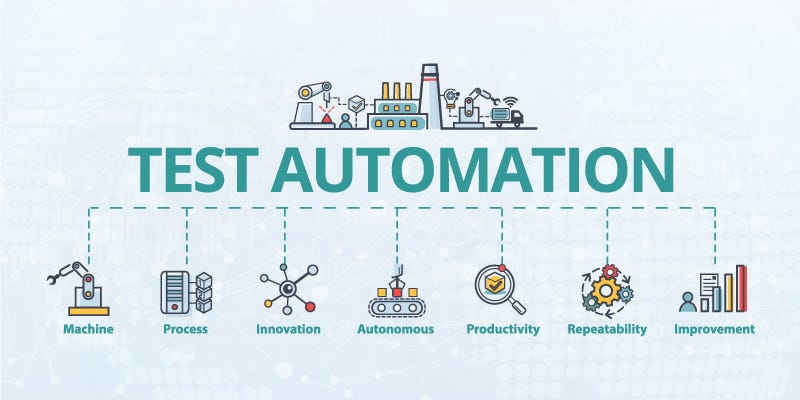Choosing the Right Tools for Effective Automation Testing Solutions
Choosing the Right Tools for Effective Automation Testing Solutions
Blog Article
Ensuring Success in Automation Checking: Key Metrics, Difficulties, and Solutions Every QA Group Ought To Know
In the world of software program top quality guarantee, the landscape of automation screening is ever-evolving, demanding a precise method to guarantee seamless procedures. The trip to grasping automation testing is paved with nuances that call for an eager eye for tracking, analysis, and continuous improvement. As the sector thrusts onward, the mission for ideal performance in automation screening continues to be a consistent quest, advising QA teams to equip themselves with the expertise and approaches necessary for victory.
Significance of Secret Metrics
Understanding the relevance of vital metrics is necessary for reviewing the efficiency and efficiency of automation testing procedures. Secret metrics function as measurable actions that offer valuable understandings into numerous aspects of the screening process, such as examination protection, examination execution time, issue density, and examination situation performance. By assessing these metrics, QA teams can recognize bottlenecks, inefficiencies, and locations for improvement within their automation screening framework.
One crucial element of key metrics is their capability to track progression and keep an eye on the overall wellness of the testing process (automation testing). They make it possible for stakeholders to make educated choices based on data-driven understandings, which can lead to a lot more reliable testing methods and far better resource allowance. Additionally, essential metrics can aid teams set sensible objectives, measure the success of automation efforts, and show the ROI of automation testing efforts

Common Obstacles Encountered
Difficulties frequently experienced in automation screening procedures can substantially impact the total effectiveness and efficiency of QA groups. One of the significant difficulties is the selection of the appropriate test instances for automation. Not all test cases are ideal for automation, and selecting the incorrect ones can result in wasted time and sources. Additionally, keeping test manuscripts can be a complicated task, specifically as the application undergoes constant modifications. Test script upkeep needs continual updates and adjustments to guarantee they show the existing functionality properly. Another usual challenge is the first investment needed for establishing up automation frameworks and devices. This can be an obstacle for some organizations, specifically smaller ones with minimal budgets. Automation screening may not cover all facets of testing, such as use and individual experience testing, which still call for hands-on intervention. Getting over these difficulties calls for proper planning, strategic test instance selection, durable maintenance procedures, adequate sources, and a clear understanding of the restrictions of automation testing.
Reliable Solutions for Challenges
To address the challenges experienced in automation testing, implementing reliable options is vital for improving the efficiency and performance of QA groups. One essential solution is to spend in robust training programs for QA teams to ensure they have the required skills to properly utilize automation devices. Training can connect knowledge gaps, enhance understanding of automation structures, and improve scripting capabilities, ultimately leading to extra effective test development and execution.
An additional important remedy is to develop clear communication networks within the QA group and with other stakeholders, such as programmers and job supervisors. Effective communication aids in aligning assumptions, sharing progress updates, and immediately dealing with concerns or obstructions that may arise during the automation screening Full Report process.

Monitoring and Evaluation Methods
Executing reliable monitoring and evaluation techniques is important for ensuring the success and performance of automation screening processes. In addition, evaluating examination outcomes and metrics offers useful understandings into the high quality of the software program being evaluated and the efficiency of the screening strategy.
One secret strategy in surveillance and analysis is making use of control panels that settle relevant metrics and KPIs in a visually easily accessible layout. These dashboards provide a detailed review of test execution condition, examination insurance coverage, defect patterns, and other important information. Consistently reviewing and evaluating these dashboards can assist QA groups make educated choices, focus on jobs, and maximize testing efforts.
In addition, carrying out automated notifies and notifications based upon predefined limits can boost proactive tracking and timely treatment. By establishing signals for efficiency deviations or test failings, groups can resolve concerns without delay and stop them from rising. Generally, tracking and analysis methods play an important role in guaranteeing the effectiveness and success of automation testing campaigns.
Continual Enhancement Methods
Enhancing the effectiveness of automation testing processes demands the constant refinement of strategies and methodologies. Continuous renovation approaches are essential for QA teams to adjust to progressing innovations and deliver high-quality software. One essential approach to boosting automation testing procedures is to carry out regular testimonials and retrospectives. By evaluating past screening cycles, teams can recognize bottlenecks, inefficiencies, and locations for enhancement. Applying comments loops and including lessons learned right into future testing structures can produce significant renovations over time.

Conclusion
Finally, it is important for QA teams to recognize the essential metrics, obstacles, and services in automation screening to make sure success. By carefully monitoring and assessing data, applying effective remedies to typical challenges, and constantly boosting techniques, QA teams can enhance their testing processes and supply premium software items. Following these methods will inevitably result in extra effective and effective automation screening practices.
By examining these metrics, QA groups can identify traffic jams, inadequacies, and areas for enhancement within their automation screening framework.
Furthermore, vital metrics can help teams established sensible objectives, measure the success of automation efforts, and show the ROI of automation screening efforts.
Challenges frequently experienced in automation testing procedures can considerably influence the total efficiency and effectiveness of QA teams. Automation screening might not cover all facets of screening, such as use and user experience testing, which still require hands-on treatment.In final thought, it is critical for QA groups to understand the key metrics, challenges, and solutions in automation testing to guarantee success.
Report this page